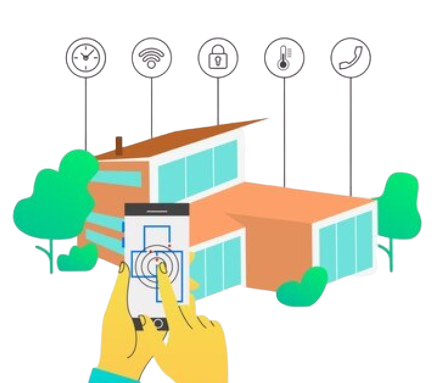The evolution of Smart Homes with IoT has already begun, and we’re just scratching the surface of what’s possible. From energy savings to enhanced security and increased convenience, the impact of IoT on modern living is undeniable. As technology advances, we can expect even smarter homes that meet our needs and anticipate them.
In recent years, the concept of smart homes has evolved from science fiction fantasies to a tangible reality, thanks to the power of the Internet of Things (IoT). Smart Homes with IoT have redefined how we interact with our living spaces, making them more efficient, secure, and comfortable. Imagine a home where your lights adjust to the perfect brightness, the thermostat learns your preferences, and security systems notify you of unusual activities—all automatically. This isn’t just convenient; it’s revolutionizing the way we live.
The Rise of Smart Homes with IoT
The journey of smart homes began with simple automation, such as programmable thermostats and remote-controlled lights. But as IoT technology developed, it opened up endless possibilities. Smart Homes with IoT now integrate a range of devices—from smart refrigerators and voice assistants to security cameras and energy management systems—into a single, cohesive network. These devices can communicate with each other, collect data, and make decisions without requiring manual input.

The driving force behind this evolution has been the rapid advancements in IoT technology. IoT enables devices to connect and exchange information seamlessly over the internet, transforming homes into interconnected ecosystems. With IoT, everything from home entertainment systems to kitchen appliances can be controlled with a tap on a smartphone or a voice command. The future is not just about convenience; it’s about smart living that is safer, more energy-efficient, and tailored to individual needs.
Key Innovations in Smart Homes with IoT
-
Intelligent Automation
Smart Homes with IoT make automation smarter. Instead of just setting up timers, IoT devices learn from your behavior. For instance, smart thermostats can track your routine and adjust temperatures based on when you’re home or away. Lights and blinds can open and close automatically depending on the time of day or weather conditions. These systems adapt to your preferences, making daily tasks easier and saving you time.
-
Enhanced Security Features
One of the most significant benefits of Smart Homes with IoT is the enhanced security features. IoT-enabled cameras, motion detectors, and doorbell systems keep an eye on your home at all times. These devices can alert you to suspicious activity, record footage, and even allow remote access to your security system. With the ability to monitor your home from anywhere in the world, you gain peace of mind knowing your home is secure.
-
Energy Efficiency
Energy efficiency is another key advantage of Smart Homes with IoT. By integrating smart devices like energy meters, smart lighting, and energy-efficient appliances, homeowners can better track and reduce energy consumption. IoT-powered systems analyze usage patterns and adjust energy usage to optimize performance. This not only reduces costs but also helps create a more sustainable home.
-
Voice Assistants and AI Integration
Voice assistants like Amazon Alexa, Google Assistant, and Apple Siri have become the backbone of many Smart Homes with IoT. These AI-powered devices enable hands-free control over everything in your home. Whether you’re adjusting the temperature, playing music, or controlling lighting, voice assistants offer a seamless way to interact with your home’s IoT system. As AI continues to evolve, these systems will become even smarter, offering personalized experiences based on voice commands and preferences.
-
Remote Control and Monitoring
Perhaps one of the most exciting features of Smart Homes with IoT is the ability to control and monitor your home remotely. From adjusting your thermostat to turning off lights, IoT devices allow homeowners to manage their homes even when they are miles away. This is particularly useful for managing energy consumption and ensuring that all appliances are off when they’re not needed. Additionally, smart security systems allow homeowners to view live footage and lock doors from anywhere in the world, offering ultimate convenience and safety.
The Future of Smart Homes with IoT
The future of Smart Homes with IoT is full of possibilities. As more devices become interconnected, homes will continue to evolve into intelligent living spaces that adapt to the needs of their residents. The integration of advanced technologies like artificial intelligence, machine learning, and 5G networks will accelerate the capabilities of smart homes, making them even more intuitive and responsive. For example, future homes may anticipate your needs before you even make a request, offering fully automated environments that require little to no input from the homeowner.
The Role of IoT in Shaping Modern Living
Smart Homes with IoT are not just about convenience—they represent a shift in how we approach everyday life. As we embrace this technology, our homes become more efficient, connected, and personalized. The growth of IoT technology will continue to shape the future of modern living, offering more opportunities to enhance the way we interact with our spaces. As homes get smarter, the quality of life improves, creating environments more responsive to our needs and aspirations.
Conclusion
The evolution of Smart Homes with IoT has already begun, and we’re just scratching the surface of what’s possible. From energy savings to enhanced security and increased convenience, the impact of IoT on modern living is undeniable. As technology advances, we can expect even smarter homes that meet our needs and anticipate them.
Tanbits offers comprehensive IoT services, helping businesses and homeowners stay ahead of the curve in the smart home revolution.
The future of Smart Homes with IoT is here—are you ready to embrace it?
BACK










